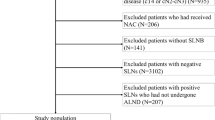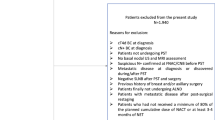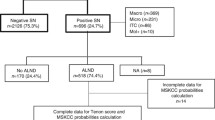Abstract
To determine which web-based model best identifies women at low risk of further axillary disease after a positive sentinel lymph node (SLN+) biopsy. 673 women with T1-2cN0M0 SNB+ breast cancer who underwent completion axillary dissection (AxD) were identified. A subgroup not eligible to avoid AxD as part of the Z0011 study was defined (Z0011 exclusion group). Predicted risk of further axillary disease was generated using seven web-based models. “Low risk” was defined as a ≤10% risk of further axillary disease. False negative (“low risk” prediction but AxD+) rates (FNRs), area under the receiver operating characteristic curve (AUC), and Brier score were determined for each model. 6 of 7 models identified “low risk” patients but FNRs ranged from 14 to 30%. The Stanford and Memorial Sloan-Kettering (MSKCC) models had the best FNRs. FNRs were lower with SLN micrometastasis (7–15%) and higher in the Z0011 exclusion group (21–41%). All models under-predicted further nodal disease in low risk patients and over-predicted in higher-risk patients. The Stanford and MSKCC models were able to identify women with SLN micrometastasis with a ≤10% FNR. Models were not able to accurately identify low risk women from a cohort that would have been excluded from Z0011.


Similar content being viewed by others
References
Giuliano AE, Jones RC, Brennan M et al (1997) Sentinel lymphadenectomy in breast cancer. J Clin Oncol 15:2345–2350
Lyman GH, Giuliano AE, Somerfield MR et al (2005) American Society of Clinical Oncology guideline recommendations for sentinel lymph node biopsy in early-stage breast cancer. J Clin Oncol 23:7703–7720
Rubio IT, Korourian S, Cowan C et al (1998) Sentinel lymph node biopsy for staging breast cancer. Am J Surg 176:532–537
Veronesi U, Paganelli G, Galimberti V et al (1997) Sentinel node biopsy to avoid axillary dissection in breast cancer with clinically negative lymph-nodes. Lancet 349:1864–1867
Krag DN, Anderson SJ, Julian TB et al (2010) Sentinel-lymph-node resection compared with conventional axillary-lymph-node dissection in clinically node-negative patients with breast cancer: overall survival findings from the NSABP B-32 randomized phase 3 trial. Lancet Oncol 11:927–933
Kamath VJ, Giuliano R, Dauway EL et al (2001) Characteristics of the sentinel lymph node in breast cancer predict further involvement of higher-echelon nodes in the axilla. Arch Surg 136:688–692
Erb KM, Julian TB (2009) Completion of axillary dissection for a positive sentinel node: necessary or not? Curr Oncol Rep 11:15–20
Cantin J, Scarth H, Levine M et al (2001) Clinical practice guidelines for the care and treatment of breast cancer: 13. Sentinel lymph node biopsy. CMAJ 165:166–173
Giuliano AE, McCall LM, Beitsch PD et al (2010) ACOSOG Z0011: a randomized trial of axillary node dissection in women with clinical T1–2 N0 M0 breast cancer who have a positive sentinel node. J Clin Oncol 18s:28s (suppl; abstr CRA506)
Chu KU, Turner RR, Hansen NM et al (1999) Do all patients with sentinel node metastasis from breast carcinoma need complete axillary node dissection? Ann Surg 229:536–541
Turner RR, Chu KU, Qi K et al (2000) Pathologic features associated with nonsentinel lymph node metastases in patients with metastatic breast carcinoma in a sentinel lymph node. Cancer 89:574–581
Giuliano AE, Kirgan DM, Guenther JM et al (1994) Lymphatic mapping and sentinel lymphadenectomy for breast cancer. Ann Surg 220:391–401
Fisher B, Jeong JH, Anderson S et al (2002) Twenty-five-year follow-up of a randomized trial comparing radical mastectomy, total mastectomy, and total mastectomy followed by irradiation. N Eng J Med 347:567–575
Guenther JM, Hansen NM, DiFronzo LA et al (2003) Axillary dissection is not required for all patients with breast cancer and positive nodes. Arch Surg 138:52–56
Giuliano AE, Hunt KK, Ballman KV et al (2011) Axillary dissection vs no axillary dissection in women with invasive breast cancer and sentinel node metastasis: a randomized clinical trial. AMA 305:569–575
Galper S, Recht A, Silver B et al (2000) Is radiation alone adequate treatment to the axilla for patients with limited axillary surgery? Implications for treatment after a positive sentinel node biopsy. Int J Radiat Oncol Biol Phys 48:125–132
Takeda A, Sigematsu N, Kondo M et al (2001) Radiotherapy after breast-conserving surgery without axillary dissection for T1–2, no breast cancer patients: comparison of the tangential and three-field irradiation technique. Int J Radiat Oncol Biol Phys 51(3):S243 (suppl 1)
Rutgers EJ, Meijnen P, Bonnefoi H (2004) Clinical trials update of the European Organization for Research and Treatment of Cancer Breast Cancer Group. Breast Cancer Res 6:165–169
Straver ME, Meijnen P, Van Tienhoven G et al (2010) Sentinel node identification rate and nodal involvement in the EORTC 10981–22023 AMAROS trial. Ann Surg Oncol 17:1854–1861
Rietman JS, Geertzen JH, Hoekstra HJ et al (2006) Long term treatment related upper limb morbidity and quality of life after sentinel lymph node biopsy for stage I or II breast cancer. Eur J Surg Oncol 32:148–152
Mamounas EP (2003) NSABP breast cancer clinical trials: recent results and future directions. Clin Med Res 1:309–326
Veronesi U, Paganelli G, Viale G et al (2003) A randomized comparison of sentinel-node biopsy with routine axillary dissection in breast cancer. N Engl J Med 349:546–553
Rietman JS, Dijkstra PU, Geertzen JH et al (2003) Short-term morbidity of the upper limb after sentinel lymph node biopsy or axillary lymph node dissection for Stage I or II breast carcinoma. Cancer 98:690–696
Mansel RE, Fallowfield L, Kissin M et al (2006) Randomized multicenter trial of sentinel node biopsy versus standard axillary treatment in operable breast cancer: the ALMANAC Trial. J Natl Cancer Inst 98:599–609
Van Zee KJ, Manasseh DM, Bevilacqua JL et al (2003) A nomogram for predicting the likelihood of additional nodal metastases in breast cancer patients with a positive sentinel node biopsy. Ann Surg Oncol 10:1140–1151
Kohrt HE, Olshen RA, Bermas HR et al (2008) New models and online calculator for predicting non-sentinel lymph node status in sentinel lymph node positive breast cancer patients. BMC Cancer 8:66
Barranger E, Coutant C, Flahault A et al (2005) An axilla scoring system to predict non-sentinel lymph node status in breast cancer patients with sentinel lymph node involvement. Breast Cancer Res Treat 91:113–119
Pal A, Provenzano E, Duffy SW et al (2008) A model for predicting non-sentinel lymph node metastatic disease when the sentinel lymph node is positive. Br J Surg 95:302–309
Degnim AC, Reynolds C, Pantvaidya G et al (2005) Nonsentinel node metastasis in breast cancer patients: assessment of an existing and a new predictive nomogram. Am J Surg 190:543–550
Katz A, Smith BL, Golshan M et al (2008) Nomogram for the prediction of having four or more involved nodes for sentinel lymph node—positive breast cancer. J Clin Oncol 26:2093–2098
Unal B, Gur AS, Kayiran O et al (2008) Models for predicting non-sentinel lymph node positivity in sentinel node positive breast cancer: the importance of scoring system. Int J Clin Pract 62:1785–1791
Dauphine CE, Haukoos JS, Vargas MP et al (2007) Evaluation of three scoring systems predicting non sentinel node metastasis in breast cancer patients with a positive sentinel node biopsy. Ann Surg Oncol 14:1014–1019
Cripe MH, Beran LC, Liang WC et al (2006) The likelihood of additional nodal disease following a positive sentinel lymph node biopsy in breast cancer patients: validation of a nomogram. Am J Surg 192:484–487
Kocsis L, Svebis M, Boross G et al (2004) Use and limitations of a nomogram predicting the likelihood of non-sentinel node involvement after a positive sentinel node biopsy in breast cancer patients. Am Surg 70:1019–1024
Lambert LA, Ayers GD, Hwang RF et al (2006) Validation of a breast cancer nomogram for predicting nonsentinel lymph node metastases after a positive sentinel node biopsy. Ann Surg Oncol 13:310–320
Smidt ML, Kuster DM, van der Wilt GJ et al (2005) Can the Memorial Sloan-Kettering Cancer Center nomogram predict the likelihood of nonsentinel lymph node metastases in breast cancer patients in the Netherlands? Ann Surg Oncol 12:1066–1072
Zgajnar J, Perhavec A, Hocevar M et al (2007) Low performance of the MSKCC nomogram in preoperatively ultrasonically negative axillary lymph node in breast cancer patients. J Surg Oncol 96:547–553
Alran S, De Rycke Y, Fourchotte V et al (2007) Validation and limitations of use of a breast cancer nomogram predicting the likelihood of non-sentinel node involvement after positive sentinel node biopsy. Ann Surg Oncol 14:2195–2201
Coutant C, Olivier C, Lambaudie E et al (2009) Comparison of models to predict non-sentinel lymph node status in breast cancer patients with metastatic sentinel lymph nodes: a prospective multicenter study. J Clin Oncol 27(17):2800–2808
Parra RFD, Ernst MF, Bevilacqua JLB et al (2009) Validation of a nomogram to predict the risk of non-sentinel lymph node metastases in breast cancer patients with a positive sentinel node biopsy: validation of the MSKCC breast nomogram. Ann Surg Oncol 16:1128–1135
R Development Core Team (2010) R: a language and environment for statistical computing. Vienna, http://www.R-project.org. Accessed November 2010
Harrell F (2001) Regression modeling strategies. Springer, New York
Krag DN, Anderson SJ, Julian TB et al (2007) Technical outcomes of sentinel-lymph node resection and conventional axillary-lymph-node dissection in patients with clinically node-negative breast cancer: results from the NSABP B-32 randomized phase III trial. Lancet Oncol 8:881–888
Tafra L, McMasters K, Whitworth P et al (2000) Credentialing issues with sentinel lymph node staging for breast cancer. Am J Surg 180(4):268–273
Houvenaeghel G, Bannier M, Nos C et al (2011) Non sentinel node involvement prediction for sentinel node micrometastases in breast cancer: nomogram validation and comparison with other models. The Breast. doi:10.1016/j.breast.2011.09.013
American Society of Clinical Oncology: ASCO perspective on JAMA breast cancer lymph node study findings http://www.asco.org/ascov2/Department%20Content/Cancer%20Policy%20and%20Clinical%20Affairs/Downloads/ASCO%20Perspective%20on%20JAMA%20Breast%20Cancer%20Lymph%20Node%20Study%20Findings.pdf. February 17, 2011
Caudle AS, Hunt KK, Kuerer HM et al (2011) Multidisciplinary considerations in the implementation of the findings from the American College of Surgeons Oncology Group (ACOSOG) Z0011 study: a practice-changing trial. Ann Surg Oncol 9(18):2407–2412
Carlson GW, Wood WC (2011) Management of axillary lymph node metastasis in breast cancer: making progress. JAMA 305(6):606–607
Acknowledgments
The authors thank Dr. Stefanie Jeffrey, Stanford School of Medicine, for providing model estimates and coefficients used to assess the Stanford nomogram for this validation.
Funding
This study was supported by a grant from the Canadian Breast Cancer Foundation-BC/Yukon Chapter.
Conflicts of interest
The authors declare no conflicts of interest related to this work.
Author information
Authors and Affiliations
Corresponding author
Rights and permissions
About this article
Cite this article
Berrang, T.S., Lesperance, M., Truong, P.T. et al. Which prediction models best identify additional axillary disease after a positive sentinel node biopsy for breast cancer?. Breast Cancer Res Treat 133, 695–702 (2012). https://doi.org/10.1007/s10549-012-1991-y
Received:
Accepted:
Published:
Issue Date:
DOI: https://doi.org/10.1007/s10549-012-1991-y




